When I first started as a SaaS sales agent, little did I know that there was much more to it than creating a sales strategy. As I delved deeper, I discovered that SaaS leaders use certain sales methodologies to train and scale their teams.

However, implementing these methodologies forcefully over your sales team might result in lower productivity and wrong sales.
Hence, different levels of the sales team would require different sales methodologies.
In this article, I’ll explore some popular sales methodologies and cover some expert advice to help you implement the right one for your business.
Table of Contents
What Is a Sales Methodology?
A sales methodology is a framework or set of principles that guide your sales reps to close clients. It takes goals and turns them into actionable steps for your reps to complete during each stage of the sales process.
For example, some sales organizations implement different sales methodologies to reach their prospects‘ pain points throughout the buyer’s journey.
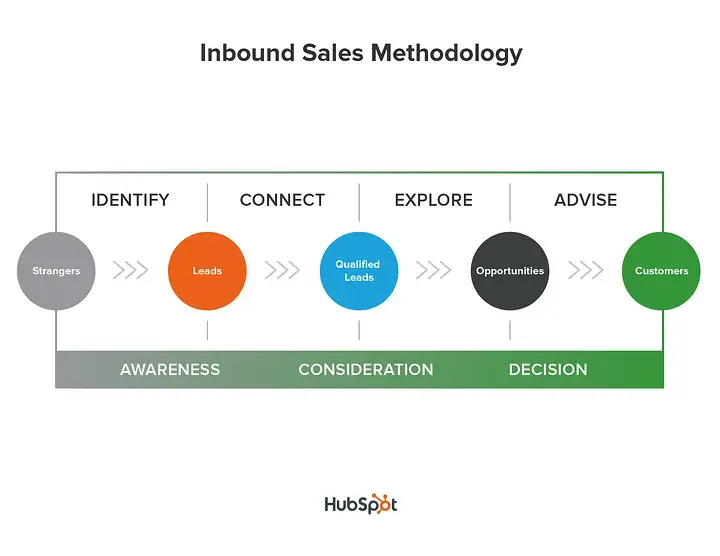
Here’s the Inbound Sales Methodology, which I learned working with HubSpot. This methodology provides an overview of how the company works to lead prospects to buy as a generalized philosophy.
Sales methodology is often used interchangeably with sales models; however, they are separate terms with notable differences.
What Is a Sales Model?
A sales model is a business’s specific approach to selling and outlines how to make a sales methodology work.
Unlike a sales process, a sales model usually doesn’t apply to the entire sales cycle.
Methodologies or models tend to be best practices relevant to one specific part of the sales cycle — whether in the qualification, discovery, demo, or follow-up stages.
One of the major differences that I found between the two approaches is related to the specificity and individual business needs. Every business has its unique sales process based on its customers’ needs, verticals, products and industry position.
Although different, your sales model/methodology still needs to align with your sales process if you want to close sales consistently — especially B2B sales.
Since no two businesses are the same, a process that works for one company could flop for another.
That’s not the case with sales models.
Different sales organizations can implement the same sales model and see similar success, no matter what their companies sell or how they function. For example, consider “The Challenger Sale” methodology, which is listed below.
Regardless of whether your business offers ERP implementation services to large enterprises or cooking supplies to local restaurants, your sales team could still see success from employing the methodology’s principles — like offering surprising insights and helping prospects navigate the buying process.
If you’re confused about which (or how many) sales models or methodologies you should use to help shape your sales efforts, don’t worry. I’ve explained various SaaS sales methodologies in detail.
Let’s take a look.
Best Sales Methodologies
- SPIN Selling
- N.E.A.T. Selling™
- Conceptual Selling
- SNAP Selling
- Challenger Sale
- The Sandler System
- MEDDIC
- Solution Selling
- Inbound Selling
- Target Account Selling
- Command of the Sale
- Gap Selling
1. SPIN Selling System
Neil Rackham popularized the term “SPIN” in his book SPIN Selling. SPIN is an acronym for the four elements a sales rep’s questions for prospects should focus on situation, problem, implication, and need-payoff. (Learn more about it in this post.)
These subjects often reveal buyer pain points and challenges and help sellers build rapport with their buyers. Rackham reported that having a solid questioning strategy can increase your closure rate by 20%.
Rackham, along with his team, studied more than 35,000 sales calls to understand what makes a salesperson successful. Based on these questions, he divided the sales conversations into four types:
- Situation questions aim to understand a prospect’s current situation — although reps should still research a call or meeting.
- Problem questions help identify the areas of opportunity and identify any gaps.
- Implication questions tell the extent of the problem for the prospect and which one should be a priority.
- Need-payoff questions guide the prospects in problem-solving through your product or service. Or, I would say, your prospect realizes the importance of your product without hard-selling.

Below, I have shared some intimidating questions that my sales team uses to ask the prospects for different stages:
- To assess situations, I ask questions such as, “What is your approach to X situation?” “How do you feel about the X situation?” and “Which is your favorite tool for X?”
- To identify the problem, I use the following questions: “How long does it take to complete the X process?” “Does the current service fit into your budget?” “Is your team familiar with the process and tools?”
- Successful salespeople ask four times as many implementation questions as their average salespersons. My favorite implementation questions include, “How much time does the X process take?” “How is a particular issue impacting productivity?” and “Has this problem drastically affected your KPIs?”
- This is the decisive stage of the SPIN system, and the questions come directly from the implications. I ask questions such as, “Does your team find value in X?” and “How does X solution make it easier for your organization to achieve the goals?”
Rather than explicitly telling prospects about a product or service’s value or potential impact, the goal of SPIN selling is to guide prospects to these realizations on their own.
Who should use SPIN selling?
SPIN selling is best for a complex sales environment where prospects have not identified their issues or understood the ramifications. It can also be helpful in remote selling and the absence of face-to-face meetings.
Pro tip: Integrate social selling into your SPIN strategy. Connect with prospects on LinkedIn and browse their profiles to get a sense of their pain points, work ethic, and more. Leverage this information in your sales call to make it more personalized.
2. N.E.A.T Selling System
Developed by The Harris Consulting Group and Sales Hacker, this qualification framework was designed to replace standbys like BANT (budget, authority, need, and timeline) and ANUM (authority, need, urgency, and money).
I use N.E.A.T selling to discover my active leads by understanding their pain points. For this sales methodology, I use a set of more empathetic and thought-provoking questions to understand the customer’s needs.
Here’s how the acronym breaks down:
- The “N” in N.E.A.T. stands for core needs. Rather than focusing on surface-level pain, this methodology’s creators urge salespeople to go deeply into their prospects’ challenges. How will this product matter to them both as individuals and within the context of the organization?
- “E” represents economic impact. Don’t simply present your solution’s ROI — help the buyer understand the financial impact they’re currently on track to realize versus the impact they’ll see if they make a change.
- “A” is access to authority. You probably won’t get to speak with the CFO, but can your champion talk to the CFO on your behalf? And more importantly, will they?
- “T,” or Timeline, refers to the exciting event forcing your prospect to make a decision. If there aren’t negative consequences to missing this date, it’s not a real deadline.
Who should use the NEAT method?
The N.E.A.T. method should be used best for lead qualification. It helps understand prospects’ needs while eliminating those who don’t qualify. Due to its extensive research, it is best for processes with longer sales cycles and big-ticket sales.
Pro tip: Focus on being more empathetic and providing emotional support to prospects to understand their mindset and gain insights into the next action.
3. Conceptual Selling System
Conceptual selling is based on the idea that customers don’t buy a product or a service — they buy the concept of a solution the offering represents. With that in mind, founders Robert Miller and Stephen Heiman urge salespeople not to lead with a pitch. Instead, they encourage sales reps to uncover the prospect’s concept of their product and understand their decision process.
I have encountered various sales leaders who consider it as the best sales methodology for SaaS.
The authors encourage salespeople to ask questions that fall into five stages:
- Confirmation questions reaffirm information.
- New information questions clarify the prospect’s concept of the product or service and explore what they’d like to achieve.
- Attitude questions seek to understand a prospect personally and discover their connection to the project.
- Commitment questions inquire about a prospect’s investment in the project.
- Basic issue questions raise potential problems.
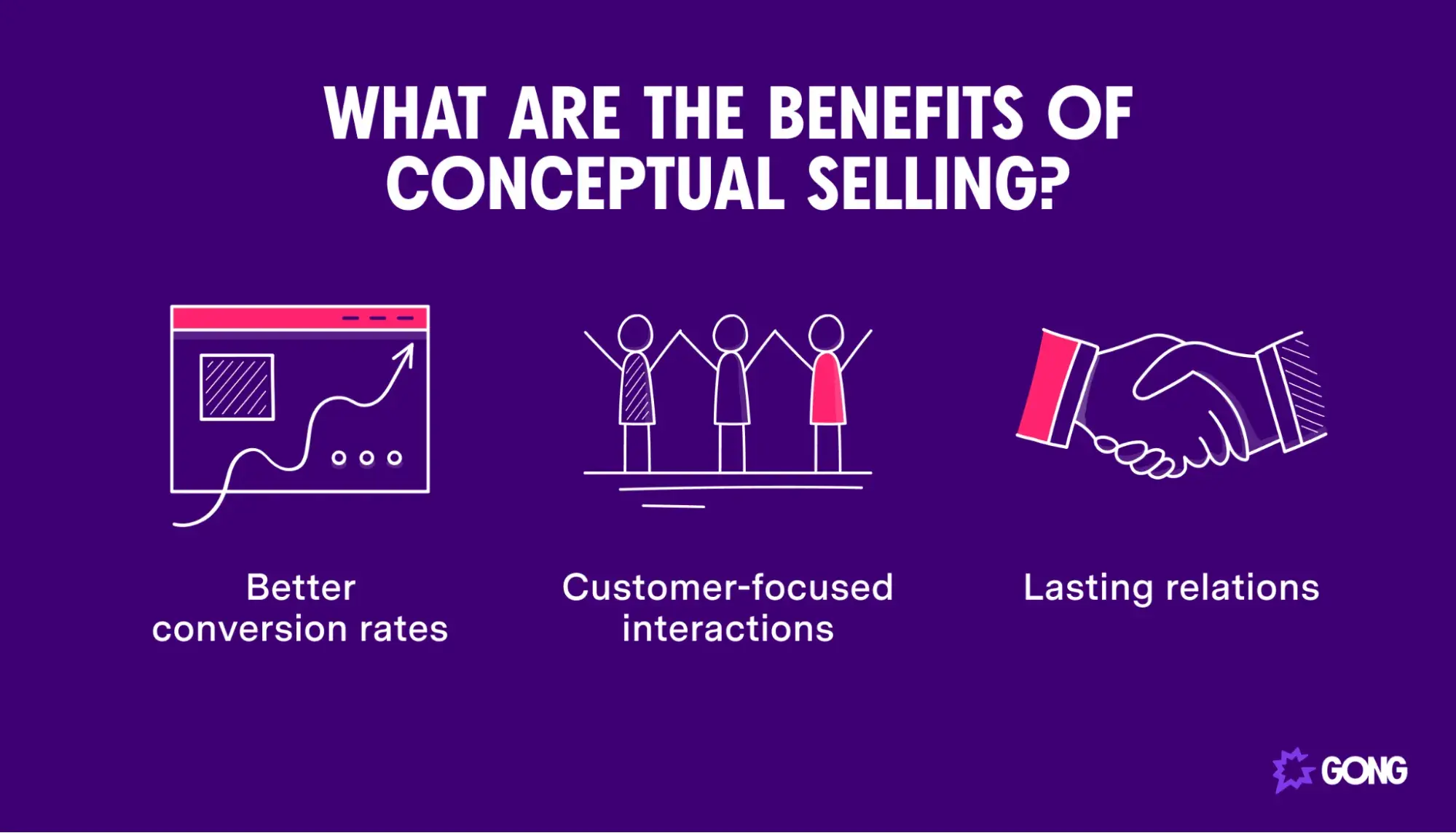
This sales methodology emphasizes listening and divides the sales process into three stages: getting information, giving information, and getting commitment.
In my opinion, conceptual selling isn’t just about closing the deal but establishing a long-term relationship with prospects who buy a product from their point of view.
Who should use the Conceptual selling system?
A conceptual selling system is good for B2B SaaS sales teams because B2B sales processes usually take longer and require more time for decision-making.
Pro tip: Like SPIN selling, use questions for the different stages of the conceptual selling system. For this sales methodology, I ask questions such as, “Would you use a new product for X task?”, “What is your timeline for this task?”
4. SNAP Selling System
SNAP Selling is a sales methodology designed for busy prospects who are easily distracted and demanding. These are my favorite types of prospects because they tend to be high-paying.
SNAP is an acronym that encompasses four directives for sellers:
- Keep it simple. Use simple questions, and make clear and concise statements rather than the jargon.
- Be i(n)valuable. Craft a message in such a way that shows your product is invaluable for your audience.
- Always align. Align your sales pitch with your prospects’ goals. In this case, I suggest using customer testimonials to show how your product satisfies their goals.
- Raise priorities. Create a list of prospects and narrow them down based on their conversion chances. I also prefer using questions and KPIs to get a clearer picture of prospects’ priorities.
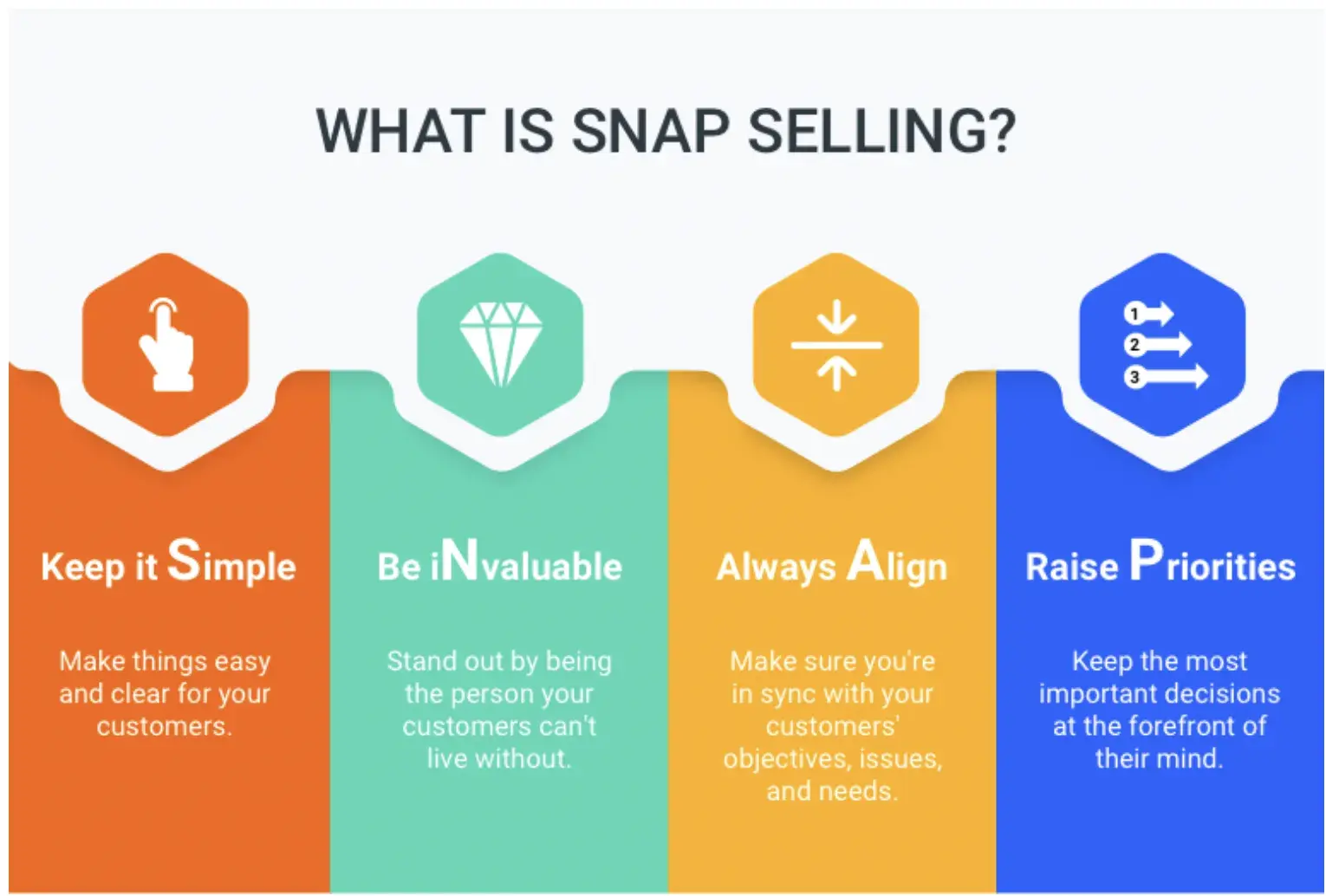
With these principles in mind, salespeople can more effectively reach busy prospects with valuable knowledge, connect what they’re selling with what’s most important to the potential client, and make it easy for them to buy.
While most salespeople think there’s only one decision involved in a deal—whether the prospect buys or not — author Jill Konrath identifies three critical decisions.
The first is allowing access. The second is choosing to move away from the status quo, and the third is changing resources. With these mini-decision milestones in mind, salespeople can more effectively keep deals on track.
Who should use SNAP selling?
SNAP selling works best for busy buyers who are easily distracted and more demanding about their needs. You’ll need to communicate better with them to ensure a smooth sales process.
Pro tip: Use social proof to show how invaluable your product is. It shouldn’t be a generalized one but rather a more goal-centric testimonial.
5. Challenger Sale
Co-authors Matthew Dixon and Brent Adamson started “The Challenger Sale” by asserting that practically every B2B salesperson fits into one of five personas: relationship builders, hard workers, lone wolves, reactive problem solvers, and challengers.
According to Dixon and Adamson’s research, salespeople are almost evenly distributed among these profiles.
Challenger Sale is about providing knowledge to prospects by challenging their current scenario. A sales rep can be a mentor to startups and convince them to try something new – out of the box.
So, what makes challengers so effective at selling? They follow a teach-tailor-take-control process.
- Teach. First, they teach their prospects — not about the product or service in question, but about more significant business problems, new ideas, and astute observations.
- Tailor. Next, they tailor their communications to their prospect.
- Take Control. Finally, they control the sales by not being afraid to push back on their customer, focusing more on the end goal than being liked. The Challenger sales methodology strives to impart the wisdom of the challenger to the other four types.
This particular approach requires well-thought-through personalized lead nurturing campaigns. These campaigns slowly warm prospects up to the business until they reach a point where they’re most likely to make a purchase.
Sales software can help reps manage and identify prospects who are most likely to convert at any given time, send personalized emails, or schedule meetings to close deals at the right moment.
Who should use the Challenger Sale system?
Challenger sales work best for the B2B SaaS sales environment, where sales reps tend to highlight the unique product features by engaging in a discussion.
Pro tip: Sales reps must shock the prospects into realization to shift their mindset from the current world to a new solution.
6. The Sandler Selling System
The Sandler Selling System flips the script of the traditional sales process — to a certain extent.
While sales have historically revolved around the idea that potential buyers should be pursued and convinced by sellers, the Sandler methodology states that both parties should be equally invested.
I found this quite similar to the NEAT method, which is used at the qualification stage. Here, the sales reps act as consultants instead of being a pushy salesperson.
It prioritizes building mutual trust between both sides. Instead of acting like a typical salesperson, the rep serves as an advisor and asks questions to identify challenges in the qualification process.
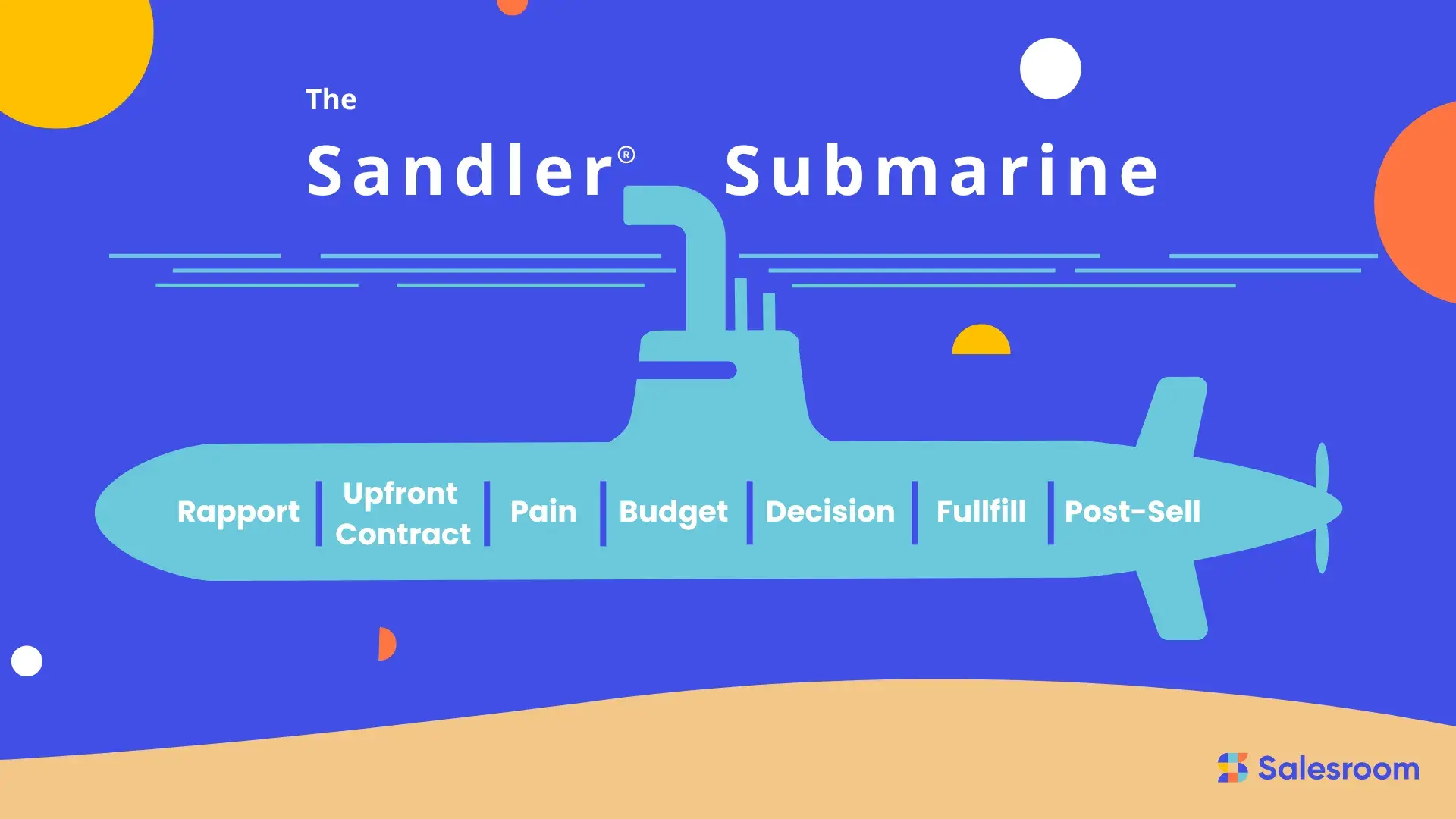
Objections such as time or budget restraints often derail deals after both the prospect and salesperson have already invested considerable work. However, Sandler-trained reps strive to assess and raise the majority of obstacles in the qualification process.
If the rep discovers that their solution won’t truly address the potential client’s concerns, they won’t waste time convincing them that it does — they’ll simply abandon the process. Rather than the seller convincing the buyer to buy, the buyer is almost convincing the seller to sell.
Who should use the Sandler selling system?
Since it is a lengthy sales methodology, it is best for high-ticket sales and large-scale SaaS products to build the prospect’s confidence in the new solutions.
Pro tip: I suggest asking the pain points smartly by reframing the direct questions into a situation or something less pushy.
7. MEDDIC
MEDDIC is a sales qualification process for complex and enterprise sales. Coined by Jack Napoli and Dick Dunkel in the 1990s, the MEDDIC framework helped them scale from $300 million to $1 billion in four years.
The acronym stands for metrics, economic buyer, decision criteria, decision process, identify pain, and champion. I prefer to use this methodology during the qualification stage and decide whether we should invest in this prospect to bring to the sales funnel.
To find the answers, ask yourself and your prospect:
- Metrics. What’s the economic impact of the situation?
- Economic buyer. Who controls the appropriate budget?
- Decision criteria. What are the formal evaluation criteria the organization is using to pick a vendor?
- Decision process. How will the organization pick a vendor? What are the specific stages?
- Identify pain. What are the trigger events and financial consequences of the problem?
- Champion. Who is selling on your behalf?
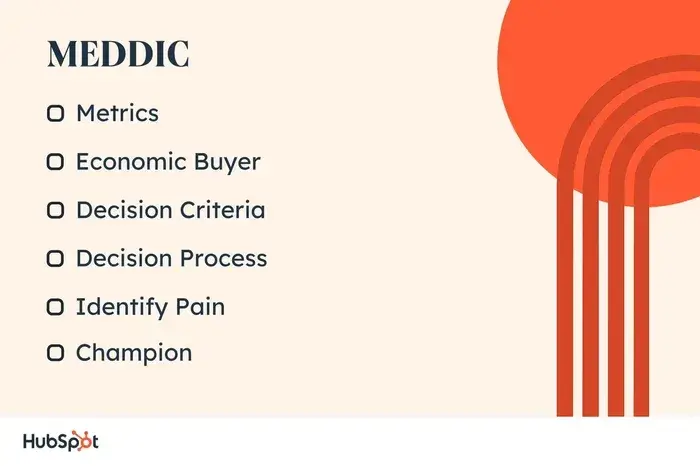
Who should use MEDDIC?
MEDDIC is best suited to enterprise organizations with complex sales processes. It works well for regular engagement with multiple stakeholders that require complex solutions for a smooth process.
Pro tip: Create a buyer persona that defines your buyers, who they are, their struggles and goals, and how these solutions can overcome the problems.
8. Solution Selling
Solution selling is a sales methodology that Mike Bosworth founded in the late 1980s from his experience at Xerox Corporation. From my experience, solution selling involves a lot of questioning and may disinterest your purchasers.
Rather than selling specific products, salespeople leverage solution-selling leads with the benefits a custom solution can provide for the prospect.
For example, a sales rep for a printing and design company could create a custom package of design services, signage, and business cards to fit the buyer’s needs.
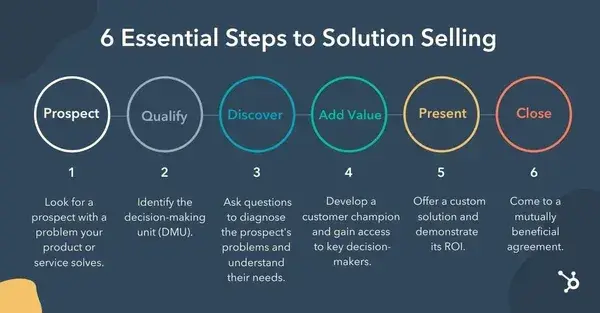
This approach acknowledges that buyers today are more informed and allows reps to meet prospects where they are. After all, prospects are likely to have already researched your products and have a solid understanding of the offerings that suit them best.
The best way to leverage this methodology is by helping my sales reps identify prospect pain points and offer a customized mix of products to meet their needs.
Who should use Solution Selling?
Solution selling works best for SaaS companies that offer more personalized products or services. For example, a company specializing in cloud security and storage will offer unique solutions to each of its customers.
I will consider various discovery calls and interactions to determine how much data my prospect needs, their security requirements, and how many devices he’ll access.
Pro tip: Develop a set of questions to diagnose prospects’ needs and tailor solutions to them. Always start with a broad set of questions that are more generalized and narrow down further to build a use case for your solution.
9. Inbound Selling
Inbound selling is the modern-day selling methodology that has replaced traditional selling methods. Simply put, potential buyers interact with the content marketing team and often research products on their own before contacting the sales team.
The inbound sales methodology allows sales professionals to meet prospects where they are, whether on Twitter or their company’s product pricing page.
In the inbound selling approach, we use a flywheel model instead of a traditional sales funnel. Not to forget, inbound sales is an effective tool for analyzing page views, conversions and social media interactions to personalize the buying process.
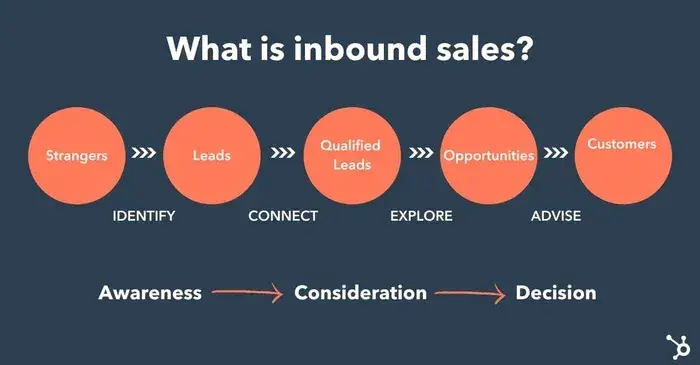
As prospects make their way through the awareness, consideration, and decision stages of the buyer’s journey, inbound sales reps take four actions:
- Identify. Inbound sales reps prioritize active buyers rather than passive ones. Active buyers have visited the company site, started a live chat, filled out a form, or reached out on Twitter.
- Connect. Inbound reps connect by reaching out to prospects with a personalized message through their blog, social media accounts, or in-person events. This personalization is based on the buyer’s role, interests, industry, or connections you have in common.
- Explore. In the exploratory phase, and reps focus on rapport building and recap previous prospect conversations. At this stage, reps dive deeper into the prospect’s challenges and goals, introduce products or services that might fit these goals, and create plans that accommodate buyer timelines and budgets.
- Advise. Finally, reps create and deliver a personalized sales presentation covering what they’ve learned about the prospect’s needs and the value and assistance your product or service can provide.
Who should use Inbound selling?
I’d say inbound selling is for everyone in the SaaS environment. It is for the SaaS sales team that wants to eliminate the cost of advertisements, reduce the outbound workforce, attract qualified leads and educate their prospects about the solutions.
Pro tip: Leverage CRMs to integrate customer touchpoints, sort the most active channels, determine the most successful type of content, and personalize the sales process to actively find leads.
10. Target Account Selling
Target account selling is the idea that picking the right prospects to engage with is the most crucial aspect of a sales process. For example, I would pay careful attention and conduct more extensive research during the lead qualification, mapping out organizations, and creating buyer personas.
This particular methodology leans heavily on sales automation — which includes the resources that can help your sales organization identify traits and characterize prospects who will be most receptive to your solution.
One critical point I like about this methodology is that it prioritizes quality over quantity significantly when pursuing leads and targeting accounts. However, I have often noticed extra legwork at the beginning of a sales process, with the hope that it will lead to higher close rates and more efficient sales efforts down the line.
Who should use Target Account selling?
Since it focuses on sustainable relationships, target account selling is best for big-ticket providers with large, complex deals and multiple decision-makers. Due to its extensive prospect research, it can be considered best for products and services involving future upgrades, upsells, and cross-sell opportunities.
Pro tip: Focus on building long-term relationships with high-value target accounts by aligning sales, marketing, and customer success teams to deliver personalized support throughout the buyer’s journey.
11. Command of the Sale
The Command of the Sale methodology involves selling with urgency, some degree of bravado, extensive product knowledge, and exceptional situational awareness — all aspects of sales that could be described as commanding in their own right.
There is always a thin line between command of the sales methodology and pushy sales reps, and this can be broadened with more sales training and coaching. This sales methodology uses internal resources for sales qualification, aligning the sales process with the customers’ buying process.
Here are the factors that I consider for the success of this sales methodology:
- What a prospect hopes to achieve.
- The ways a prospect wants to create value for their business.
- How the rep’s solution — specifically — can fulfill those elements.
- How the prospect measures success.
- Why the rep’s business stands out from its competition.
With those bases covered, a salesperson operating within this methodology needs to be able to explicitly define how their solution suits their prospects’ problems, needs, and interests in a way their competition can’t.
That pitch has to be enough to warrant charging a premium for their company’s product or service.
Who should use Command of the Sale?
Command of the Sale is best suited for SaaS teams that require a structured and predictable sales process. It also helps the sales team improve efficiency and forecasting accuracy.
12. Gap Selling
Gap Selling is a methodology rooted in highlighting the gap between a prospect‘s business’s current state and their desired future state. Its underlying premise is addressing problems rather than touting products.
In the sales world, gap selling is about understanding the customer’s pain points, fears, challenges and dreams.
With gap selling, reps prioritize prospects. They develop a deep, fundamental understanding of a potential customer’s business, issues, and — perhaps most importantly — goals. Then, they determine the best possible way to position their product or service as the most effective means of filling those gaps.
Developing that understanding means digging deep, pinning down the root causes for any trouble a prospect might be having. As you may assume, that kind of intense examination can be time-consuming, so this methodology best suits sales teams that have the time and flexibility to take a holistic look at a prospect’s situation.
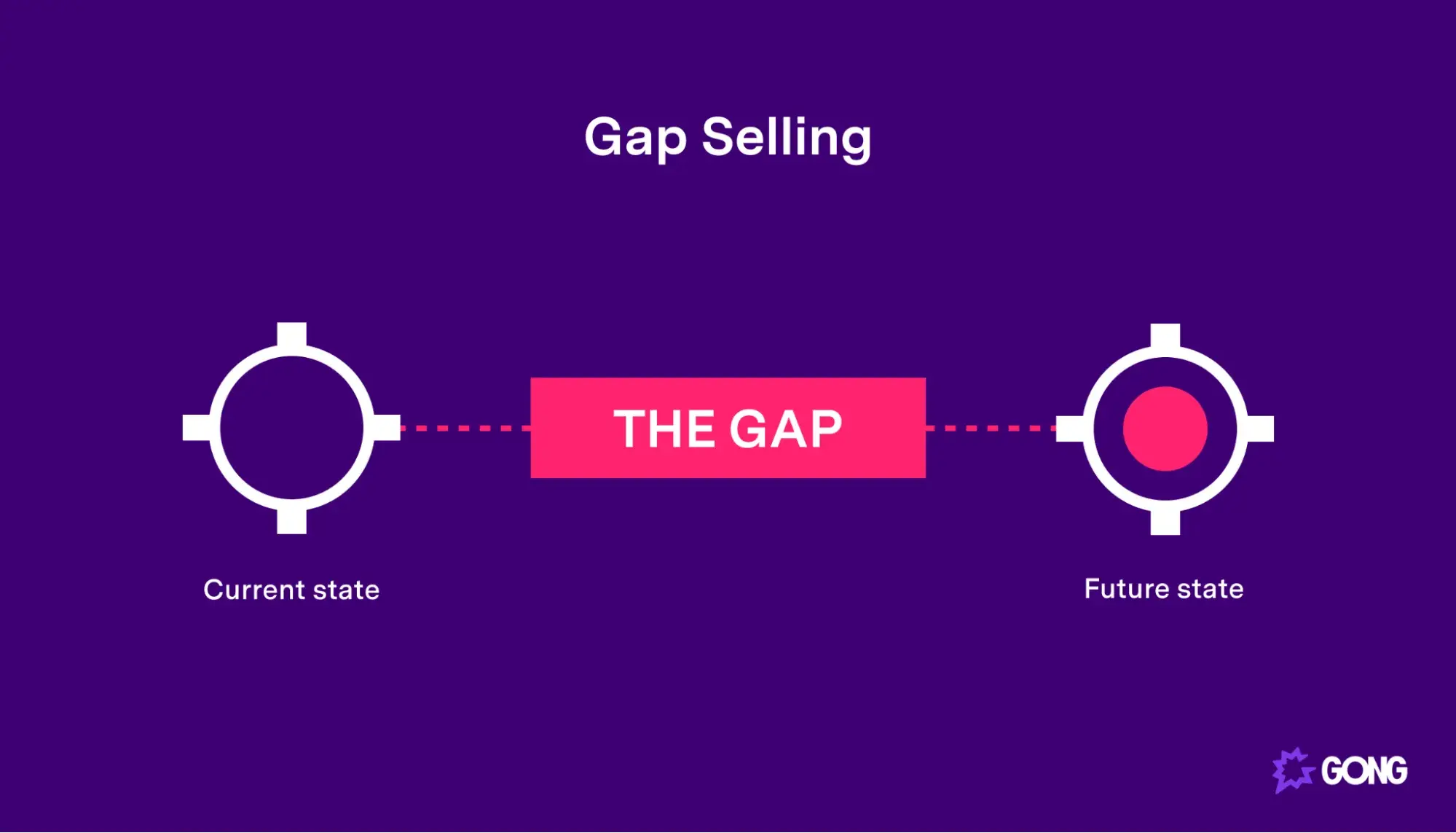
Who should use Gap Selling?
Gap selling works for the sales team, which needs ample time to investigate the prospect’s condition and ask the necessary questions to identify the prospects.
Pro tip: While performing gap selling, track the key sales metrics to get better insights into the effectiveness of the sales strategies. For example, I prefer key metrics such as pipeline metrics, customer interactions, and interaction time to gather these insights.
Customer-Centric Sales Methodology
The customer-centric sales methodology promotes meaningful conversations with prospects to identify their needs and find solutions that solve their challenges. The salesperson targets critical decision-makers and asks questions to understand their situation, align with their needs, and offer relevant solutions.
Customer-centric selling methodology enables salespeople to be flexible in their approach to discovering the buyer’s priorities, needs, and schedules.
Here are the eight key components of CCS methodology:
1. Have a conversation rather than deliver a presentation.
I’ll say it out loud: customer-centric selling is about prioritizing empathy for the customer above all else. This means understanding where customers are coming from and the specific situations they might be dealing with.
Initiate a conversation rather than delivering a presentation. One-size-fits-all presentations aren’t personal enough. With this methodology, you need to adapt and converse based on the customer’s individual needs and experiences.
2. Ask relevant questions instead of offering opinions.
“If you are not taking care of your customer, your competitor will.” This is my favorite sales quote by Bob Hooey.
Empathy is the operative concept in customer-centric selling. You want customers to know you’re listening, feel like you’re genuinely concerned with their best interests, and understand you’re thinking about solutions specific to their individual needs. If you’re dominating the conversation with opinions and not considering their perspective, you’re not engaging in customer-centric selling.
3. Focus on the solution instead of the relationship.
The key to customer-centric selling is to understand that your priority isn’t selling — it’s solving. The point of the whole model is to understand a specific situation for an individual customer and offer a fitting solution. If you can do that, a solid relationship should follow. But simply building that relationship can’t be your main priority.
4. Target decision-makers instead of users.
Customer-centric selling focuses on the use of a product and the specific problems it can consistently solve. It’s less about the product’s features and more about what day-to-day use of it looks like.
Instead of being pushy, use a soft tone and focus on being more empathetic with the decision-makers. After all, it is not the users who make the purchase decision.
5. Promote product usage to garner interest.
This point ties into the one above. Customer-centric selling revolves around showing how using the product you’re selling will make life easier for your prospect. Instead of discussing a product’s features and assuming your potential customer will figure out how to apply them on their own, show what the product can do and demonstrate how it can solve their specific problems.
6. Strive to be the best seller rather than the busiest.
My main motto: Quality over quantity.
That’s the name of the game when it comes to customer-centric selling. According to this methodology, it’s better to apply your effort toward finding solutions for fewer individual customers than to spread yourself thin and halfway-commit to several customers.
Pro tip: Create a list of prospects and assign a number based on their priority. Use this list to create content and sales pitches accustomed to different prospects.
7. Close on the buyer’s timeline rather than the seller’s timeline.
One common mistake I often find with novice sales reps is that they work on their terms and schedule. Customer-centric selling is based on your customer’s best interests and specific dilemmas. Getting there isn’t always going to be easy, quick, or straightforward.
Don’t press your customers to stick to your schedule. Ideally, you’ll be able to help your customer come to a resolution on a schedule that works for both of you. But ultimately, it’s their solution. It’s their business. So, it’s going to have to happen on their time.
8. Empower buyers to buy instead of convincing them.
The fundamental reason for every instance of customer-centric selling is simple — the customer has a problem. Your job as a salesperson is to empower them in their effort to solve it.
You’re not selling a product so much as you’re selling a solution. Your priority should be to show how your product fits that solution — not how awesome your product happens to be in general. You’re selling to them for them. Be sure to keep that in mind.
How to Implement a New Sales Methodology
To help you get a better idea of how to put one of these methodologies into your sales plan, I reached out to some HubSpot sales experts.
Here’s what they say about implementing a new sales methodology:
Rachael Plummer — Former HubSpot Global Manager, Solutions Provider Program
“Salespeople today are inundated with content. So while I think it‘s the best time to be a sales rep, it’s also the hardest! There are a million different ways to have a connect call, send an email, or find new leads — and sales reps have to constantly parse through that content to pin down what they deem to be significant enough to implement in their day-to-day.
So as a sales leader, it‘s critical that if you are going to present a team with a new sales methodology and disrupt their current flow, you need to keep the capacity of new information the team is going to choose to retain in mind. Once I’ve determined that a new sales methodology is worth adopting, there are a few things I like to focus on to make it easier.
First, it‘s imperative that as a leader, you believe in the methodology yourself. For the team to prioritize this particular methodology, they have to know you believe in it too and that you’re capable of implementing it. A reverse role play works really well here, where you, as the sales leader, play the rep and your team plays the customer.
Next, I like to emphasize how this new approach will help both the team and our customers. As a team, we have to believe in the mission — we have to see a North Star. Why would someone who continually achieves their goals stop doing what they‘re doing if they don’t see the greater value?
This can be achieved by demonstrating an anticipated increase in leads, meetings, sales, or customer retention. If there isn’t meaning behind the approach or a clear path to success, it will not receive the calories it deserves.
Finally, I like to ensure that the steps in a new sales methodology are outlined as simply as possible. Can it be digested and adopted within a matter of minutes? If we’re going to ask a salesperson to take a step back in their day away from immediate revenue-generating activities, then that has to be the goal.”
David Torres — HubSpot LatAm Sales Director
“Whenever a methodology is introduced, and change is needed, the first thing I try to do — before presenting it to my team — is to understand what will stay the same. There are bound to be changes, but there‘s probably going to be a starting place of transition that looks similar to what we’re already doing.
Often, we index on the changes, but change can be incredibly uncomfortable. I want to champion change as evolution and as a continuity of the things we’re already doing well.
The change itself essentially becomes evolution as a natural consequence of improvement. Why would I choose not to do things better when we’ve evolved to the point that we can actually do things better?
In a team meeting, I present the change and the ‘why’s,‘ but I start to draw the parallels of what’s going to continue or the iterations that need to be made. Here’s where you give your team a minute to reflect — a place where you can highlight how what you were doing today is going to evolve.
For instance, let‘s say we used to prospect via email, and now we need to pick up the phone. There’s a parallel between what you wrote in your email and the script you‘ll use when you call. It’s not ‘new,’ it’s an evolution.
Another example could be telling your team, ‘Now, we’re going to use GPCT to qualify rather than just BANT alone. BANT worked because of XYZ — you should look at GPCT as a continuation of BANT through context.
Change, in my experience, is best absorbed through small chunks. I don’t need to migrate all of it by myself 100% on day one. But, if I set a target of where I want to be a month out, I can strive for progress rather than perfection. The same goes for the team.”
Dan Tyre — Former HubSpot Executive
“Methodology changes can be easy or complicated based on the degree of change required. Slight changes — like adding or refining individual steps or updating the questions used during a stage of a process — are largely tactical and easy to implement.
The sales team should recognize the change, understand the update, and implement it over a matter of weeks to get the desired outcome. But if you are completely rewiring a sales process — like upgrading to an inbound sales or consultative sales approach — you need to leverage a more comprehensive and flexible strategy.
Start with the goal and work backward. For instance, say, ‘We want to close more deals’ — something most sales teams will be on board with.
Next, you need to move to the data.
You might be implementing a methodology change because what you‘re seeing as individuals or a team is that you’re not moving from stage one to stage two, in keeping with the expectations of your industry or organization. That means you have to try something different — in this context, that’s adopting a new sales methodology.
That‘s going to require some change management. Some reps get it quickly, while others will take some more time. After all, your methodology has probably been ingrained in your sales process for years, and that’s okay!
As long as you and your team are making progress, and your reps understand that they‘re going to have to work through these changes within a set window of time, you’ll be in a good place.
It also helps to institute a film night — a designated time where you listen to calls with the team to show new methodology’s steps and best practices, allowing your team to more effectively model the process.
After a reasonable amount of time, your most nimble reps should be up and running, but some ‘slow percolators’ might need some extra help. In those cases, you review the overall goals and benefits of the methodology, zero in on the difficult segments, and take baby steps to address and improve the delivery.”
Start Using the Best Sales Methodologies
From my experience, choosing the right sales methodology can make or break a deal. Each methodology offers a unique approach tailored to different stages of the sales process.
For instance, I‘ve found the SPIN Selling method to be particularly effective when uncovering a prospect’s pain points and guiding them toward realizing the value of my solution on their own.
On the other hand, for enterprise-level sales, the MEDDIC approach helped us qualify prospects and ensured decision-maker’s buy-in.
Understanding and implementing the right methodology at the right time is crucial. It’s not just about selling; it’s about providing tailored solutions that resonate with your prospects’ needs.
In sales, the prospect is the priority. Their success should be the focal point of any deal you make. Every sales transaction should enable a buyer to achieve a goal, solve a problem, or satisfy a need.
Finding the sales methodology that allows you to consistently fulfill those ends is central to creating meaningful sales efforts that will build productive, mutually beneficial relationships with loyal customers.
Editor’s note: This post was originally published in February 2020 and has been updated for comprehensiveness.


